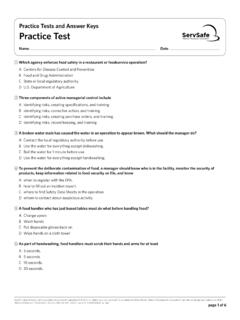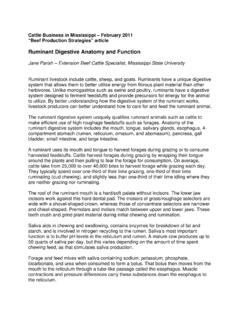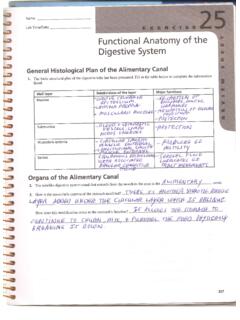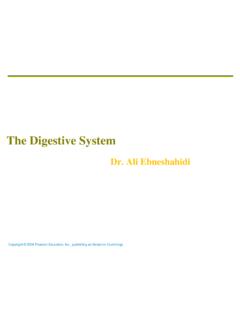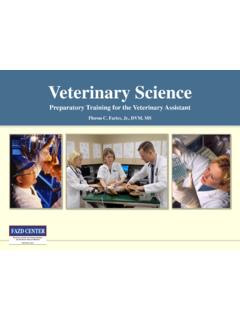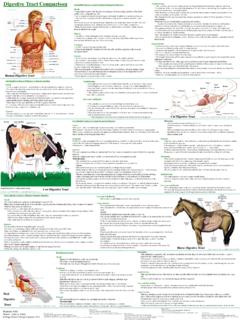Transcription of Understanding the Ruminant Animal Digestive System
1 Understanding the Ruminant Animal Digestive SystemRuminant livestock include cattle, sheep, and goats. Ruminants are hoofed mammals that have a unique Digestive System that allows them to better use energy from fibrous plant material than other herbivores. Unlike monogastrics such as swine and poultry, ruminants have a Digestive System designed to ferment feedstuffs and provide precursors for energy for the Animal to use. By better Understanding how the Digestive System of the Ruminant works, livestock producers can better understand how to care for and feed Ruminant Digestive anatomy and FunctionThe Ruminant Digestive System uniquely qualifies Ruminant animals such as cattle to efficiently use high roughage feedstuffs, including forages.
2 anatomy of the Ruminant Digestive System includes the mouth, tongue, salivary glands (producing saliva for buffering rumen pH), esophagus, four-compartment stomach (rumen, reticulum, omasum, and abomasum), pancreas, gall bladder, small intestine (duodenum, jejunum, and ileum), and large intestine (cecum, colon, and rectum).A Ruminant uses its mouth (oral cavity) and tongue to harvest forages during grazing or to consume harvested feedstuffs. Cattle harvest forages during grazing by wrapping their tongues around the plants and then pulling to tear the forage for consumption. On average, cattle take from 25,000 to more than 40,000 prehensile bites to harvest forage while grazing each day.
3 They typically spend more than one-third of their time grazing, one-third of their time ruminating (cud chewing), and slightly less than one-third of their time idling where they are, neither grazing nor roof of the Ruminant mouth is a hard/soft palate without incisors. The lower jaw incisors work against this hard dental pad. The incisors of grass/roughage selectors are wide with a shovel-shaped crown, while those of concentrate selectors are narrower and chisel-shaped. Premolars and molars match between upper and lower jaws. These teeth crush and grind plant material during initial chewing and aids in chewing and swallowing, contains enzymes for breakdown of fat (salivary lipase) and starch (salivary amylase), and is involved in nitrogen recycling to the rumen.
4 Saliva s most important function is to buffer pH levels in the reticulum and rumen. A mature cow produces up to 50 quarts of saliva per day, but this varies, depending on the amount of time spent chewing feed, because that stimulates saliva and feed mixes with saliva containing sodium, potassium, phosphate, bicarbonate, and urea when consumed, to form a bolus. That bolus then moves from the mouth to the reticulum through a tube-like passage called the esophagus. Muscle contractions and pressure differences carry these substances down the esophagus to the eat rapidly, swallowing much of their feedstuffs without chewing it sufficiently (< inches).
5 The esophagus functions bidirectionally in ruminants, allowing them to regurgitate their cud for further chewing, if necessary. The process of rumination or chewing the cud is where forage and other feedstuffs are forced back to the mouth for further chewing and mixing with saliva. This cud is then swallowed again and passed into the reticulum. Then the solid portion slowly moves into the rumen for fermentation, while most of the liquid portion rapidly moves from the reticulorumen into the omasum and then abomasum. The solid portion left behind in the rumen typically remains for up to 48 hours and forms a dense mat in the rumen, where microbes can use the fibrous feedstuffs to make precursors for ruminants, such as cattle, sheep, goats, deer, and antelope, have one stomach with four compartments: 2the rumen, reticulum, omasum, and abomasums.
6 The Ruminant stomach occupies almost 75 percent of the abdominal cavity, filling nearly all of the left side and extending significantly into the right side. The relative size of the four compartments is as follows: the rumen and reticulum comprise 84 percent of the volume of the total stomach, the omasum 12 percent, and the abomasum 4 percent. The rumen is the largest stomach compartment, holding up to 40 gallons in a mature reticulum holds approximately 5 gallons in the mature cow. Typically, the rumen and reticulum are considered one organ because they have similar functions and are separated only by a small muscular fold of tissue.
7 They are collectively referred to as the reticulorumen. The omasum and abomasum hold up to 15 and 7 gallons, respectively, in the mature reticulorumen is home to a population of microorganisms (microbes or rumen bugs ) that include bacteria, protozoa, and fungi. These microbes ferment and break down plant cell walls into their carbohydrate fractions and produce volatile fatty acids (VFAs), such as acetate (used for fat synthesis), priopionate (used for glucose synthesis), and butyrate from these carbohydrates. The Animal later uses these VFAs for reticulum is called the honeycomb because of the honeycomb appearance of its lining.
8 It sits underneath and toward the front of the rumen, lying against the diaphragm. Ingesta flow freely between the reticulum and rumen. The main function of the reticulum is to collect smaller digesta particles and move them into the omasum, while the larger particles remain in the rumen for further view of Ruminant Digestive tract. Left-sided view of Ruminant Digestive tract. Honeycomb interior lining of the reticulum in an 8-week-old calf. The reticulum also traps and collects heavy/dense objects the Animal consumes. When a Ruminant consumes a nail, wire, or other sharp heavy object, it is very likely the object will be caught in the reticulum.
9 During normal Digestive tract contractions, this object can penetrate the reticulum wall and make its way to the heart, where it can lead to hardware disease. The reticulum is sometimes referred to as the hardware stomach. Hardware disease is discussed in detail in Mississippi State University Extension Publication 2519 Beef Cattle Nutritional The rumen is sometimes called the paunch. It is lined with papillae for nutrient absorption and divided by muscular pillars into the dorsal, ventral, caudodorsal, and caudoventral sacs. The rumen acts as a fermentation vat by hosting microbial fermentation.
10 About 50 to 65 percent of starch and soluble sugar consumed is digested in the rumen. Rumen microorganisms (primarily bacteria) digest cellulose from plant cell walls, digest complex starch, synthesize protein from nonprotein nitrogen, and synthesize B vitamins and vitamin K. Rumen pH typically ranges from to The rumen environment is anaerobic (without oxygen). Gases produced in the rumen include carbon dioxide, methane, and hydrogen sulfide. The gas fraction rises to the top of the rumen above the liquid abomasum is the true stomach of a Ruminant . It is the compartment that is most similar to a stomach in a nonruminant.





